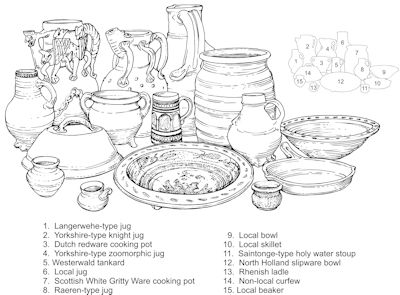
The pottery from these excavations amounts to a small assemblage of c.5000 sherds, largely medieval and abraded. Small assemblages of this type are of limited statistical value, and therefore only a small amount of comparison with other sites has been attempted. Many of the sherds were residual, especially in the burial soils, and the pottery found within these soils was generally very abraded.
Pottery found on sites in Aberdeen includes a substantial proportion which was made in the Aberdeen area, but also some which was imported from other parts of Scotland, from England, France, Germany, the Low Countries, Spain and elsewhere (for further discussion of this see Murray 1982, 116-77 and Cameron and Stones 2001, 153-77). Of the 4212 sherds from the 1994 excavation, approximately 65% are from vessels produced in the local area and 35% from imported pots. Interestingly the pottery from Phases 1a to 4 (inclusive) is approximately half local and half imported, whereas 70% of the pottery from all Phase 5 (a-e) contexts is of local origin.
Not only does pottery reveal local, national and international trading contacts, but it can indicate details of diet and cooking methods. The pottery published here adds to our understanding of this important artefact from the medieval and later periods, although the actual location of the local industry, probably somewhere outside the burgh, and possibly just a few hundred metres south of the Carmelite site at an area called Clayhills, continues to elude us (Cameron 2016).

Much of the pottery found at this site had been moved over time from the position in which it was originally discarded. Some sherds will, therefore, be of an earlier date than others in the same layer. This pottery is termed 'residual'. This can occur for example when rubbish is cleared from a yard into a midden area or pit, or when a pit is cleaned out or redug and the finds are scattered elsewhere. Pottery fragments which are moved in this way are usually smaller than those which are newly discarded, and their edges are worn. This is particularly true at this site in the burial soils where a small number of very abraded sherds of medieval pottery have probably been moved several times by the digging of successive, often intercutting, graves. Sometimes layers contain predominately residual pottery, and it is often difficult to date these layers with any accuracy. At this site pottery, flints, coins, worked stones and documentary evidence have been used in conjunction to date the phases of activity. Figure 16 shows a range of pottery in use during the period that the Carmelites occupied this site.
Internet Archaeology is an open access journal based in the Department of Archaeology, University of York. Except where otherwise noted, content from this work may be used under the terms of the Creative Commons Attribution 3.0 (CC BY) Unported licence, which permits unrestricted use, distribution, and reproduction in any medium, provided that attribution to the author(s), the title of the work, the Internet Archaeology journal and the relevant URL/DOI are given.
Terms and Conditions | Legal Statements | Privacy Policy | Cookies Policy | Citing Internet Archaeology
Internet Archaeology content is preserved for the long term with the Archaeology Data Service. Help sustain and support open access publication by donating to our Open Access Archaeology Fund.